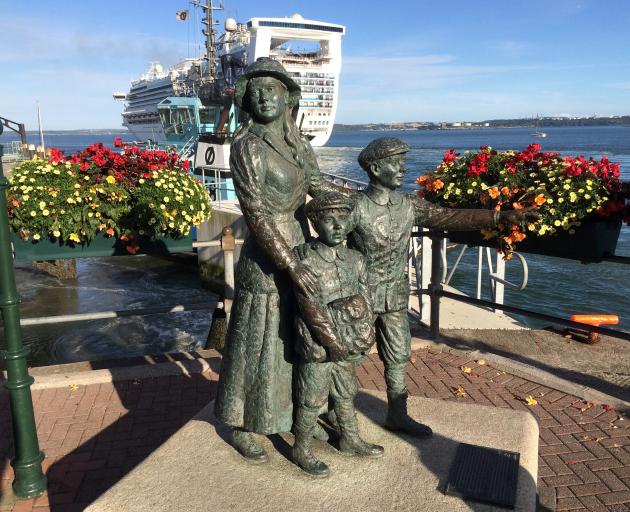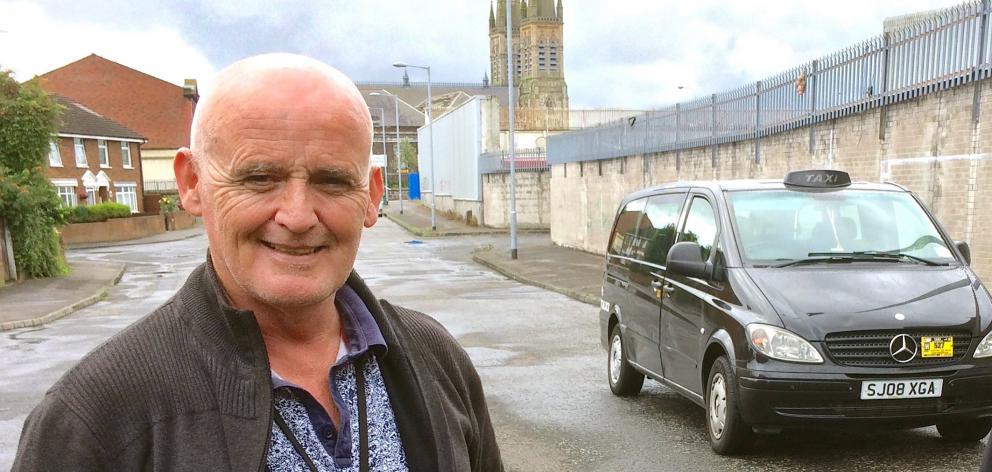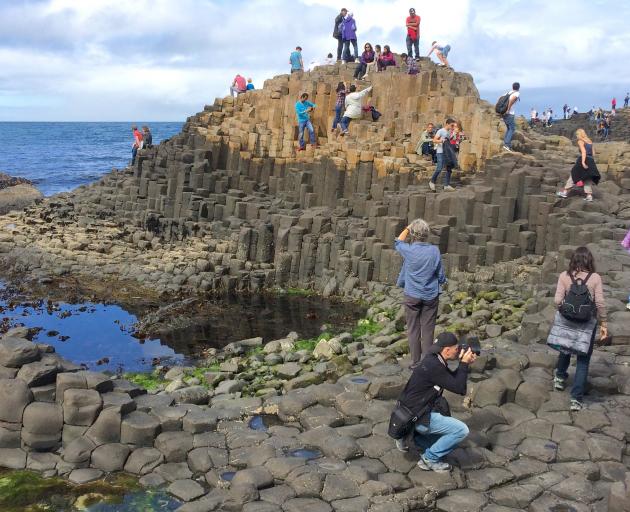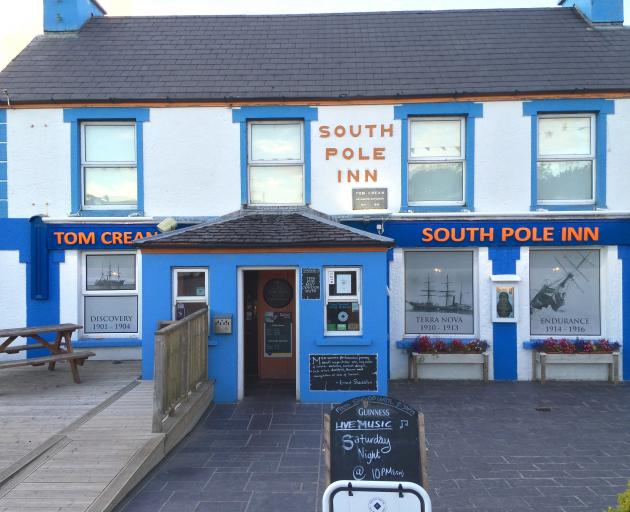
In Ireland, when does a road that appears to be for one-way traffic become a two-laner? Answer, when someone optimistically paints a white dotted line down the middle. Were we living some kind of Irish joke?
But let's not get too far ahead of ourselves. All journeys have to begin somewhere and our 10-day Irish escapade began in southwest Scotland at the newish Cairnryan ferry terminal, strategically located where the Irish Sea narrows to just over 30km.
Day 1 (August 19): Boat
Took a rental car into the belly of the promisingly named P&O ferry Europe Causeway, a decent size with amenities galore, including a lounge for posh passengers and a digital games room. Sea smooth, lit with murky sunshine. As we approach the Northern Ireland port of Larne, sea and sky become dull grey - mirroring the stone facades of Larne itself. Welcome to the Emerald Isle. First town we stop at is Carrickfergus, where we book into bed-and-breakfast accommodation for two nights then dine at an ancient hotel with low door frames where my fish meal arrives groaning with potatoes, eight of them. Potato blight not a bother this year.

Down the road in Belfast, the once-troubled capital of Northern Ireland, we take a recommended Black Taxi Tour. Our Carrickfergus hosts said it would enlighten us about the ugly period of sectarian conflict in Northern Ireland between Catholic republican activists and Protestant UK loyalists that erupted in the late 1960s and 1970s. Our Black Taxi driver, Jim O'Neill, while keeping his sectarian powder dry so to speak, makes straight for a Falls Rd area to show us a high steel fence separating Catholic and Protestant precincts. It's shocking to realise such a grim metal barrier still exists, fitted with steel gates that slide shut overnight. Half a century on from the start of The Troubles, Belfast still has a steel barrier through the middle of its suburban sprawl. Near this first stop, the O'Neill family of nine children lived. It was a struggle to make ends meet. A short walk away was a flour mill owned by UK interests but their father, like most Catholics, had no show of getting a job.
One day Jim, aged 13, was crossing the road near his home, when suddenly he was lifted off his feet. For no apparent reason, he was shot in the arm and back by a British soldier manning a roadblock a couple of hundred metres away. Jim rolls up his shirt sleeve now to reveal the scar. The Troubles involved violent rioting, over 3000 deaths from gunfire and bombs and the imprisonment of IRA activists and sympathisers by the thousand. Around Catholic precincts the Union Jack was called the "Butcher's Apron''.
Clearly feelings still run deep, if less violently. Jim, in his 50s now, says his children show little interest in The Troubles; they just want to get on with their lives. That evening we eat fish 'n' chips and seafood chowder in the stylish old Europa Hotel in the centre of Belfast. Known as Europe's most bombed hotel in the 1970s as a result of IRA attacks, the Europa is model of dignified dining for our visit.

Heading north through County Antrim by way of the coast road, we have a geological landmark as a destination - the Giant's Causeway. As Ireland's only Unesco World Natural Heritage Area, it naturally gets a lot of tourism attention but I am surprised by both the scale of this volcanic formation and its pulling power. In mid-summer the place is teeming with visitors (5000 a day is not uncommon).
After passing picturesque coastal villages bedecked in Union Jack flags we detour on to a signposted "coastal scenic drive'' called Torr Head, featuring cliffs and hilly farmland, emerald green to be sure. The asphalt road becomes narrow, often trenched between drystone walls and banks of pretty fuchsia bushes that allow no room to dodge oncoming traffic. An SUV approaches rather fast, suggesting local knowledge, the driver grim-faced. We pass, at low speed now, with millimetres to spare between our side mirrors. Scenery yes, but no chance to enjoy it, and white centre lines that are having you on.
The Giant's Causeway's columnar basalt dwarfs Dunedin's Organ Pipes formation. There are said to be 40,000 individual columns here, and they range from stepped stonework at the shoreline that Inca stonemasons would be proud of, to overhanging crags on the cliffs. Even crawling with visitors, this landscape is a stunner, a product of lava cooling at just the right rate to create tight-fitting joints.

Day 4: Galway
A short drive from the lodge takes us to another natural coastal landmark, the seriously high cliffs of Slieve League. Rising 600m above the North Atlantic Ocean, these are said to be the highest sea cliffs in Europe. Not that the agile and remarkably tame black-faced sheep, grazing on knobbly, treeless grasslands, would give a toss about such a record.

Galway Bay, halfway down Ireland's western seaboard, beckons by way of national highways whose new sections are a motoring breeze, so smooth and roomy. Like many parts of Ireland, Galway enjoys a fabled Celtic history. Galway City is on our itinerary because we are invited to stay with a Dunedin-born and educated marine scientist, Prof Peter Croot, and his Chilean-born wife, Gilda. Peter is head of marine science at the National University of Ireland. The city lies at the head Galway Bay, a much-studied inlet over 60km long, the outer reaches of which are conveniently guarded by a row of islets, the Aran Islands. The North Atlantic Current moderates Galway's climate. Without such a warm current, Galway would be much colder because it lies in latitude 53deg north. In the New Zealand region, latitude 53deg is to the south of subantarctic Campbell Island, the Furious Fifties.
Day 5: Connemara
Our hosts live a stone's throw from a gravel shore on Connemara Peninsula and they want to show us more of their region. The rugged Galway Bay shoreline is a maze of inlets and estuaries as well as unusual coral sand beaches that from a distance resemble the more common creamy quartz sand of Otago beaches. Known as marl beaches, they comprise tiny white and golden coral (calcium carbonate) chips mixed with shell fragments from sea urchins and limpets.

Day 6: Tralee

Tralee's city centre, where we book into a hotel, is still lit up for the world-famous Rose of Tralee event but the crowds have gone, thank goodness. I have an Irish polar legend in mind because of my own modest Antarctic experience. Tom Crean performed valiantly on Captain Scott's two Antarctic expeditions, which passed through Dunedin in the first decade of the 20th century, and the Irishman was also with Sir Ernest Shackleton for the 1914-17 drama of the Endurance expedition. Making use of the lingering dusk, we set out for the township of Anascaul on nearby Dingle Peninsula, where Crean was born and set up not only a home for his young family but also a pub, the colourful South Pole Inn. Today, it's a convivial memorial to Crean along with a new statue of him cuddling husky pups plus a couple of plaques and his grave site not far away. We toast him in his old pub and leave for Tralee before darkness settles.
Day 7: Cork
Farewelling Tralee's atmospheric narrow streets, we head west for Cork, the county next door and Ireland's second-largest city (after Dublin). Cork's history dates from the 6th century. Irish highways are more interested in getting you from A to B than directing you to recreational opportunities such as woodland walks and lake scenery, and beaches don't seem to figure largely, either.

Day 8: Diaspora
Cork's patron saint, Finbarr, is commemorated by way of a striking cathedral. Its spires were completed in 1879 on a downtown site that has known a succession of churches since the Middle Ages. There's also dramatic history down at Cork's main port, Cobh (Cove) - the Irish diaspora of the 19th and 20th centuries. Almost half of the six million Irish men, women and children who emigrated between 1840, when potato famines began, and 1950 departed from here for a better life abroad. Anywhere had to be an improvement on mass starvation, widespread disease and English oppression that lasted centuries. Countries of choice included the United States and Canada, but also included the West Indies, Australia and New Zealand. Resembling refugees, legions of emigrants poured out of Cobh.
Thanks to a kindly Cobh museum staff member, who let us into the Heritage Centre after closing time, we get to see a poignant recapturing of those times in words, images and maritime memorabilia - a display that also recalled the massive loss of life in the sinking of the Cunard liners Titanic, which sailed from Cobh in 1912, and Lusitania (1915), which was sunk by a German U-boat torpedo off the Cork coast.
But despite their tragic past the Irish, Celtic to the core, are never short of a song and strong drink. In the evening our Cork hosts show us a cafe bar where we quaff down the local stout beer (Beamish and Murphy) as musicians bang out jigs and reels, new and old.

More interested in towns and villages than cities, we decide not to explore Dublin but journey north without too much of a plan. Except for calling at Athy ("aah-tie''), Sir Ernest Shackleton's home town until he was 10 and the family moved to London. The Athy Heritage Centre makes a big deal of him, to the point of erecting a statue so new it had yet to be unveiled. The centre is normally closed at weekends but when I inquired at a nearby historic grocery store about the chances of seeing through it, phone calls were made and the centre was suddenly open to reveal all kinds of Shackleton artefacts, from a sledge used on his Nimrod expedition to various letters and a brooch worn by his wife, Emily.
The new motorway north, courtesy of European Union funds, is a marvel compared with the rural roads. It sweeps travellers along at legal speeds of up to 120kmh, with road safety enhanced by a median barrier and a generously wide shoulder. We arrive in a region of ancient cultural sites that include pre-Celtic burial mounds and, at Mellifont, a Cisterian abbey founded in the 12th century - a fascinating stroll through stone ruins.
Lack of booked lodgings overnight can become an issue. A recommended coastal resort town, Carlingford, is swarming with visitors and has no beds available. Nor have nearby Dundalk and Newry. As dusk falls we cross the border into Armagh and, with visions of spending the night in the car, finally secure a room at a hotel that is still serving food after 9pm. Blessed relief, so it is!
Day 10: Haste Ye Back
In bright sun next morning, Armagh's twin-towered St Patrick's Cathedral is spectacular, although the interior, featuring carved pillars, painted ceilings and effigies of saints, is even more impressive. The Larne ferry will return us to Scotland, where visitors are commonly told, Haste Ye Back! This saying conveys the feel of Ireland as well, to be sure, a land of quirkiness, hospitality and history.












